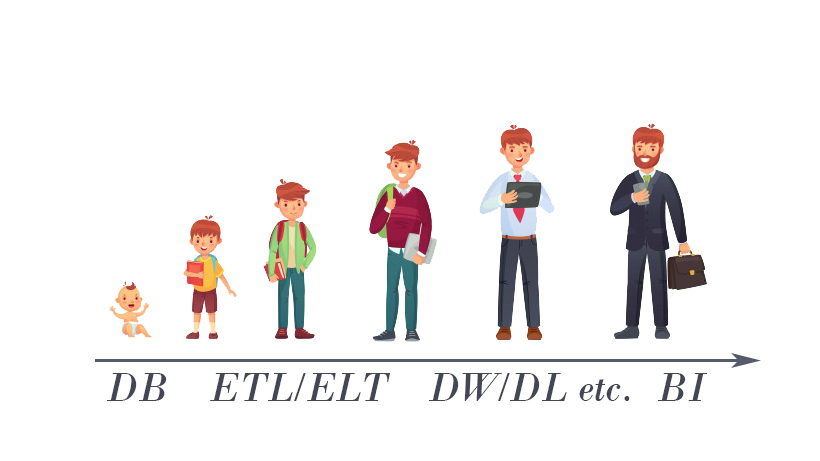Data Literacy: The ABCs of Business Intelligence
Business in the 21st century revolves around one key tenet: Use data well. Exploring how companies do this — and how you can, too — will be the guiding principle for our series of articles dedicated to Business Intelligence (BI), Data, and overall best practices for making quick, meaningful business decisions. Over several installments, we’ll explore good data usage from the ground up. This exploration will begin with the most fundamental necessity of all: Data Literacy.
Table of contents
What is Data Literacy?
Data Literacy is the starting and ending point of effective BI. Data Literacy is to BI what the alphabet is to reading comprehension; all related concepts depend squarely upon it. So, what is Data Literacy, and how do companies nurture it?

Gartner defines Data Literacy as the ability to read, work with, analyze, and communicate with data. It’s a skill that empowers all levels of workers to ask the right questions of data and machines, to build knowledge, to make decisions, and to communicate meaning to others.
Data is the new oil: the fuel which propels businesses of all sizes to success. Being Data Literate means that you know how to utilize that fuel in the most efficient and sensible ways.
Data Literacy is the first step in the data-nurturing process. We like to think of this process like childrearing, where the company represents the child’s parents. By creating a healthy, educational data environment, companies can raise their data into productive, informed members of the clan.
Keeping this framework in mind, each of our BI articles will be devoted to a stage of the data-nurturing process:
- Data Analysis (using BI Tools)
- Data Transformation and Conversion (ETL)
- Data Storage (Databases, Data Warehouses, etc.)
We’ll study the above topics through the prism of our experience — which, by the way, spans almost 30 years of business analytics work with more than 100 different partners. To the extent that it’s possible, we’ll keep academic and technical terminology to a minimum (though, if you’re interested, you’ll be able to find that information in the links we provide), instead we suggest to spend time exploring the aspects of BI that we want to highlight as the most immediately useful to you.
In the last installment of the series, we’ll summarize all of the information we covered, drawing conclusions about how to implement good BI practices in your organization. But that’s a long way off — for now, let’s get back to data-nurturing.

Data Nurturing Plan
Whether or not you cultivate high-quality data depends entirely on the environment in which it lives. As you begin down the path toward more sophisticated Data Literacy, ask yourself: Am I developing a culture of Data Literacy within my company? If no, why not?
New parents read parenting books about how to create healthy environments for their children. It’s exactly what they should be doing: They’ve never been through this before, and so getting advice from experts will help them avoid common problems. Why not apply a similar approach to your data?
The Data Literacy knowledge gap is a huge pain point for the BI community in general, and for product vendors particularly. According to the Qlik Data Literacy Report, only 24% of business decision-makers are “fully confident in their ability to read, work with, analyze, and argue with data.” Fortunately, that lack of confidence is complemented by an appetite for learning: 78% are “willing to invest more time and energy into improving their data skillsets.”
People know that BI products which will help them visualize and leverage their data have a lot of upside, but they don’t have the skills necessary to realize it. To meet this issue head-on, many vendors are developing programs to overcome it. For example, Qlik, one of the most prominent BI Tool vendors, established the Data Literacy Education Institute, devoted solely to helping people turn data-based self-doubt into knowledge and confidence.
Why is Data Literacy Important for Your Business?
It’s no secret that the companies who lead the way in the digital world are those who make the most of analytics capabilities in their operations. This is a given. Because it’s a given, many other companies strive to do the same. But there’s a big difference between a desire and meaningful action, and all too often, meaningful action is impeded by insufficient Data Literacy. This not only hinders companies’ abilities to become market leaders, it also reduces their ability to manage cultural data change throughout their organizations.
Ours is an era in which data is the basis of nearly all competition. Companies live or die by their ability to obtain information and conquer the market. Lack of Data Literacy is a millstone for companies with competitive aspirations.
What does Data Literacy give us? It gives us fresh insights and practical wisdom on how to empower employees, leverage the best tools for training, and make the most of new opportunities. All of this helps companies build a competitive edge. It’s a full-fledged strategy that will transform your business and strengthen employees loyalty through investment in their and yours professional development. Data Literacy underlies all effective BI. Beyond that, everything else is just knowing how to use the right tools.

For any company, thorough Data Literacy is a major step in determining what they need to do to move forward. It allows companies to track cause and effect in business operations and, just as importantly, to correctly store and display this information using the proper tools. When you master these topics, you’ll understand how to make accurate predictions about the future.
No single school can boast that all of its students are prodigies. Likewise, there are many different schools of thought regarding Data Literacy and Data Culture that you can apply within your organization. You can work with all of the staff, or just a part; you can create a small subset of data masters, or a broader squad of reasonably strong users. In a cheeky — but apt — depiction, Qlik illustrates the gradation thus:
 One way or another, shepherding employees through this process will make them better data citizens. This will undoubtedly yield positive effects on their work and the performance of the company as a whole.
One way or another, shepherding employees through this process will make them better data citizens. This will undoubtedly yield positive effects on their work and the performance of the company as a whole.
How Do I Create a Culture of Data Literacy Within My Organization?
By this point, you might be saying to yourself: Okay, I believe in the benefits of Data Literacy. But creating a Data Literature culture seems tricky. Where do I begin?
Well, for starters, it’s useful to understand the key challenges that often get in the way of becoming data literate.
Cultivating Data Literacy means revamping old traditions. While data has always been captured in some form or fashion, it’s only recently that data collection, storage, and utility has been put at such a premium. So, organizations that have functioned for a long time without rigorous data procedures must now evolve.
Evolving this way depends on several key factors. First, the leaders of an organization need to become the greatest champions of Data Literacy. Executives especially should put Data Literacy culture front and center, making it clear to all members of the organization that data will drive decisions.
Likewise, leaders must understand that, while higher education is beginning to incorporate Data Literacy into core curricula, many university graduates still rank themselves below average when it comes to this subject. Educational resources should be readily available within the organization, and organizational silos must be dissolved, creating a more all-inclusive Data Culture for all.

In terms of specific programs, there are numerous resources available for those who wish to cultivate Data Literacy in their organizations. These tools alone won’t make you a data pro, but they can be great places to start.
- Qlik Data Literacy Program. Designed to accommodate even the most novice hopefuls, the Qlik Data Literacy Program is a comprehensive, industry-leading strategy and framework.
- Qlik Data Literacy courses. Specialized courses developed to help employees and organizations to understand, analyze, and use data with confidence.
- The Data Literacy Project. Founded in 2018, the London-based Data Literacy Project is a nonprofit organization devoted to “making the language of data understood and communicated effectively by everyone.”
Without sufficient levels of Data Literacy in your business, it’s hard to know how to work with your data effectively. Because of that, it will be very challenging to develop a clear picture of your true needs and goals and nurture your data respectively. Organizations in this position who spend resources on deploying and leveraging BI Tools would be wasting their time and money.
You wouldn’t try to teach a child to read without first educating them their ABC’s — and you certainly wouldn’t start them off with Moby-Dick. Cultivate Data Literacy first. It’s an essential step toward making the most of your organization’s data.
We at IBA Group could talk about Data Literacy for hours — and we regularly do with our clients and partners. If this article has piqued your interest, visit Analytics and Data Engineering dedicated pages on our website to learn more about how our experience and insights might be useful to you.
Conclusion
In this brief article, we got acquainted with the basics of data analysis, giving us a groundwork for understanding the core pillar that it stands on. In our next article, we’ll dive into the complex world of BI Tools, which help your data take shape in the form of dynamic and static reports, pie and bar charts, interactive dashboards, and much more. For now, take a brief coffee break, and then jump back in to learn more!